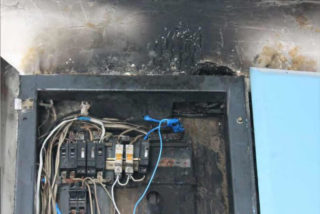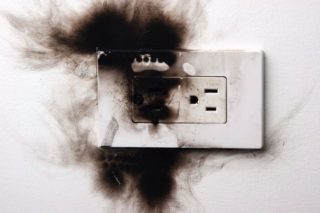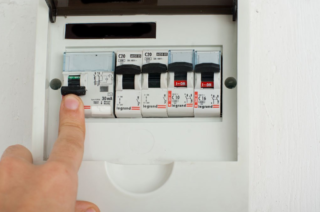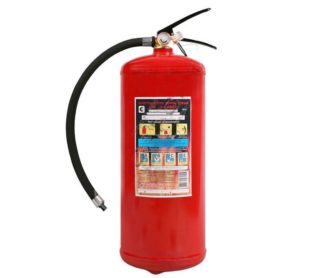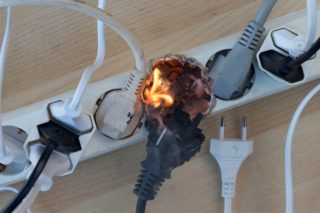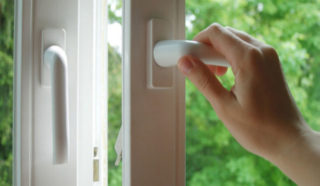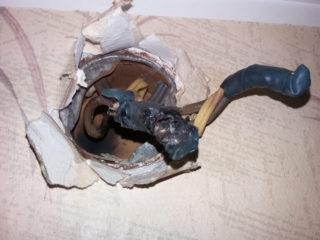Electricity makes human life more comfortable and convenient. At the same time, it is a source of increased danger, which is the cause of more than half of the ongoing fires in the country. As a result, people die, expensive property is destroyed, residential buildings and utility buildings become worthless. When purchasing real estate, its owners cannot know about the condition of the wiring installed in it and the purchased household appliances. Knowing what to do if the wiring caught fire, you can quickly and without serious consequences avoid an emergency.
Fire causes
Cable ignition can occur for the following reasons:
- Overload on the line. When several powerful consumers are connected, the conductive sections begin to get very hot. If the critical temperature is exceeded, ignition of the wiring and finishing materials occurs.
- Short circuit. Upon contact of the cores, an arc arises, the temperature of which is so high that the metal melts and the destruction of the supporting structures. Often this is due to mechanical damage or deterioration of the insulation.
- Oxidation of contacts. During operation, the metal in them oxidizes, resistance increases, a fire occurs due to electrical wiring, which has not been tested and maintained for a long time.
- Laying lines on flammable materials. It is typical for open wiring, when cables are laid in plastic boxes that do not have a fire protection class. Products ignite, both from strong heating, and from a flash of a short circuit.
- Damaged power supply cable from household appliances. Defects occur in places of bending, splicing, due to exposure to fire or accidental cut.
If the wiring caught fire, you need to know how to act in an extreme situation in order to get out of it with minimal moral and material losses.
Procedure for identifying the first signs of fire
Signs that the wiring is on:
- the light starts blinking, dies away with time;
- may smell burnt plastic in the room;
- the occurrence of cod coming from walls or mounting boxes;
- the appearance of white or black smoke;
- darkening of walls in the places of cable laying.
When a fire occurs, the following measures should be taken:
- Keep calm, inspire yourself and others that the situation is under control and its elimination is a simple and safe matter.
- If there is such an opportunity, turn off the power to the apartment - unscrew the plugs, turn off the machine.
- Arrange for women and children to immediately enter the porch, start notifying housemates and call the fire brigade.
- Close windows and doors to stop oxygen from reaching the flame.
- Wet a towel and wrap it around your face to protect your respiratory system from toxic smoke.
- Crouch or crawl around the premises in search of a fire.
- Disconnect all household appliances from the network. After that, throw a blanket, plaid or other dense fabric on the burning device. If there are flowers in flowerpots nearby, you can use the soil in them.
- Proceed to extinguish the fire using all available methods.
If the situation is uncritical, you need to turn off the lights and conduct an examination of outlets, switches and mounting boxes.Fire due to wiring most often occurs in these places in the presence of low-quality twists and contacts. A defect is fused plastic, soot and blackened walls. The cable may burn out in the strob. You can determine this using the tester. In this case, you will have to change part of the wiring.
Methods of extinguishing burning wiring
If the wiring is lit, it should be extinguished immediately to prevent the spread of fire. If this is not done immediately, a fire can cover all rooms and spread to neighboring apartments.
To extinguish a burning cable, you can use the following types of fire extinguishers:
- Water and foam. They form a large volume of water foam, blocking the access of oxygen to smoldering or burning material. Foam conducts current, so use fire extinguishers is allowed only if there is a power outage.
- Powder The products are compact and easy to use on lines that are energized up to 380 V. They cover the ignition area with an airtight layer, as a result of which combustion ceases. Cannot be used in conditions of strong traction and on vertical surfaces.
- Carbon dioxide. They are the most effective fire extinguishing agent. The feed stream has high pressure and low temperature. As a result of exposure, the flame is eliminated and the smoldering objects are simultaneously cooled. Designed to extinguish installations under voltage up to 10,000 V.
Instructions for the use of fire extinguishers are printed on their enclosures. Before purchasing, you should read them and clarify the expiration date. Disposal of fire extinguishers should be carried out in specialized organizations.
How to extinguish live wiring
If the wiring in the apartment caught fire, it is necessary to make the right decision regarding the choice of means for eliminating the flame. Thoughtless actions can only exacerbate an already difficult situation.
The use of the following means for extinguishing energized wiring is strictly contraindicated:
- Water and any solutions based on it. Such liquids conduct electricity well. You can get an electric shock immediately when pouring water. Further, the situation only becomes more complicated, since the liquid spreads across the floors, turning the apartment into a zone of increased danger.
- Factory-made and home-made alcoholic beverages. They light up when heated, a pungent smell can cause poisoning, and carbon dioxide - loss of consciousness.
- Food products (vinegar, sauces, broths). Firstly, they contain water. Secondly, when they are heated, preservatives enter the air, steam and smoke are created, which affects the visibility.
- Synthetic fabrics. From contact with fire, they melt, flare up and emit large amounts of toxic smoke. Surrounding objects with a low flash point can ignite from such materials.
The best means of fighting fire (in the absence of fire extinguishers) are leather, fur and canvas. These materials are non-combustible and airtight, which is the main condition for fighting the flame. If the wiring burns out, but everything else has survived, spoiled clothing is a trifle.
What to do if you can’t put out the fire
Apartments filled with wooden and plastic products can burn out in a matter of minutes. But the main danger to human life is not smoke, but smoke. This must be taken into account when deciding on the course of action in a critical situation.
If the fire fails, the following measures are recommended:
- Close all windows, interior doors tightly and leave the house, taking with you the phone, documents and valuables. Indoors, the fire moves slowly. There is a chance that he will not flare up before the arrival of firefighters.
- If the front door is blocked by fire or smoke, close in the bathroom. After that, wet the towels and plug the gaps with them. Then water the door leaf to prevent its ignition and through burning.
- When there is a lock in the back room, you need to use the window for breathing, calls for help or access to the fire escape, which will be a great success.
If all of the above methods were not available, you need to lie on the floor by the window, breathe through natural tissue and wait for salvation. Do not try to break through the fire and smoke to the exit. From heat exposure and toxic gases, you can instantly lose consciousness and burn out alive.
Precautionary measures
Preventive measures to prevent wiring fires take time and money, but all this is not comparable with the consequences of a fire.
The following rules are recommended:
- Not to include several powerful consumers at the same time, as this creates a critical load on the line.
- Do not connect copper and aluminum wires directly. This is a dangerous option, which sooner or later will cause an emergency.
- Install a residual current device in the apartment. With its help, housing will be automatically de-energized even before the moment of fire.
- Inspect sockets, junction boxes, and switches annually. It is necessary to clean and strengthen the contacts, update the insulation.
- Before leaving the apartment, turn off household appliances that are used periodically. When leaving on vacation, completely de-energize the room.
To be prepared for the most unfavorable scenario, you should purchase a carbon dioxide or powder fire extinguisher and teach the whole family how to use it.
